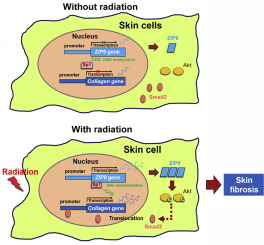当前位置:
X-MOL 学术
›
J. Invest. Dermatol.
›
论文详情
Our official English website, www.x-mol.net, welcomes your
feedback! (Note: you will need to create a separate account there.)
Genome-Wide Analysis Reveals Zinc Transporter ZIP9 Regulated by DNA Methylation Promotes Radiation-Induced Skin Fibrosis via the TGF-β Signaling Pathway.
Journal of Investigative Dermatology ( IF 5.7 ) Pub Date : 2019-06-27 , DOI: 10.1016/j.jid.2019.04.027 Yuyou Qiu 1 , Yiying Gao 2 , Daojiang Yu 3 , Li Zhong 2 , Weichao Cai 4 , Jiang Ji 4 , Fenghao Geng 5 , Guangyu Tang 1 , Huojun Zhang 6 , Jianping Cao 3 , Jie Zhang 5 , Shuyu Zhang 7
Journal of Investigative Dermatology ( IF 5.7 ) Pub Date : 2019-06-27 , DOI: 10.1016/j.jid.2019.04.027 Yuyou Qiu 1 , Yiying Gao 2 , Daojiang Yu 3 , Li Zhong 2 , Weichao Cai 4 , Jiang Ji 4 , Fenghao Geng 5 , Guangyu Tang 1 , Huojun Zhang 6 , Jianping Cao 3 , Jie Zhang 5 , Shuyu Zhang 7
Affiliation

|
Radiation-induced skin fibrosis is a detrimental and chronic disorder that occurs after radiation exposure. DNA methylation has been characterized as an important regulatory mechanism of multiple pathological processes. In this study, we compared the genome-wide DNA methylation status in radiation-induced fibrotic skin and adjacent normal tissues of rats by methylated DNA immunoprecipitation sequencing. Radiation-induced fibrotic skin showed differentially methylated regions associated with 3,650 protein-coding genes, 72 microRNAs, 5,836 long noncoding RNAs and 3 piwi-interacting RNAs. By integrating the mRNA and methylation profiles, the zinc transporter SLC39A9/ZIP9 was investigated in greater detail. The protein level of ZIP9 was increased in irradiated skin tissues of humans, monkeys, and rats, especially in radiogenic fibrotic skin tissues. Radiation induced the demethylation of a CpG dinucleotide in exon 1 of ZIP9 that resulted in recruitment of the transcriptional factor Sp1 and increased ZIP9 expression. Overexpression of ZIP9 resulted in activation of the profibrotic transforming growth factor-β signaling pathway through protein kinase B in human fibroblasts. In addition, radiation-induced skin fibrosis was associated with increased zinc accumulation. The zinc chelator N,N,N',N'-tetrakis(2-pyridylmethyl)-1,2-ethylenediamine abrogated ZIP9-induced activation of the transforming growth factor-β signaling pathway and attenuated radiation-induced skin fibrosis in a rat model. In summary, our findings illustrate epigenetic regulation of ZIP9 and its critical role in promoting radiation-induced skin fibrosis.
中文翻译:

全基因组分析揭示锌甲基化调控的锌转运蛋白ZIP9通过TGF-β信号通路促进辐射诱导的皮肤纤维化。
辐射诱发的皮肤纤维化是一种有害的慢性疾病,发生在辐射暴露后。DNA甲基化已被表征为多种病理过程的重要调控机制。在这项研究中,我们通过甲基化DNA免疫沉淀测序比较了辐射诱导的大鼠纤维化皮肤和邻近正常组织中全基因组DNA甲基化状态。辐射诱导的纤维化皮肤显示出与3,650个蛋白质编码基因,72个microRNA,5,836个长非编码RNA和3个与小卵磷脂相互作用的RNA相关的差异甲基化区域。通过整合的mRNA和甲基化配置文件,锌转运蛋白SLC39A9 / ZIP9进行了更详细的研究。在人,猴子和大鼠的受辐照皮肤组织中,尤其是在放射源性纤维化皮肤组织中,ZIP9的蛋白质水平增加。辐射诱导ZIP9外显子1中的CpG二核苷酸脱甲基,导致募集转录因子Sp1和增加ZIP9表达。ZIP9的过表达导致人成纤维细胞中通过蛋白激酶B激活纤维化转化生长因子-β信号通路。另外,辐射引起的皮肤纤维化与锌积累增加有关。锌螯合剂N,N,N',N'-四(2-吡啶基甲基)-1,2-乙二胺消除了ZIP9诱导的转化生长因子β信号通路的激活并减弱了辐射诱发的皮肤纤维化。总而言之,我们的发现说明了ZIP9的表观遗传调控及其在促进辐射诱发的皮肤纤维化中的关键作用。
更新日期:2019-12-19
中文翻译:

全基因组分析揭示锌甲基化调控的锌转运蛋白ZIP9通过TGF-β信号通路促进辐射诱导的皮肤纤维化。
辐射诱发的皮肤纤维化是一种有害的慢性疾病,发生在辐射暴露后。DNA甲基化已被表征为多种病理过程的重要调控机制。在这项研究中,我们通过甲基化DNA免疫沉淀测序比较了辐射诱导的大鼠纤维化皮肤和邻近正常组织中全基因组DNA甲基化状态。辐射诱导的纤维化皮肤显示出与3,650个蛋白质编码基因,72个microRNA,5,836个长非编码RNA和3个与小卵磷脂相互作用的RNA相关的差异甲基化区域。通过整合的mRNA和甲基化配置文件,锌转运蛋白SLC39A9 / ZIP9进行了更详细的研究。在人,猴子和大鼠的受辐照皮肤组织中,尤其是在放射源性纤维化皮肤组织中,ZIP9的蛋白质水平增加。辐射诱导ZIP9外显子1中的CpG二核苷酸脱甲基,导致募集转录因子Sp1和增加ZIP9表达。ZIP9的过表达导致人成纤维细胞中通过蛋白激酶B激活纤维化转化生长因子-β信号通路。另外,辐射引起的皮肤纤维化与锌积累增加有关。锌螯合剂N,N,N',N'-四(2-吡啶基甲基)-1,2-乙二胺消除了ZIP9诱导的转化生长因子β信号通路的激活并减弱了辐射诱发的皮肤纤维化。总而言之,我们的发现说明了ZIP9的表观遗传调控及其在促进辐射诱发的皮肤纤维化中的关键作用。











































 京公网安备 11010802027423号
京公网安备 11010802027423号